179 Queens Drive, Liverpool, Merseyside, L15 6XS
This well-known public house is at one of Liverpool’s busiest roundabouts, built in c1931, where Childwall (ponounced ‘chilled wall’) meets the neighbouring suburb of Wavertree. The Childwall Fiveways Hotel had been a local landmark for more than 50 years. A newspaper cutting from the local Evening Express, dated 12 December 1956, is entitled ‘MP pulls first pint at new pub’. The Childwall Fiveways Hotel takes its name from the five exits leading off the roundabout.
Photographs and text about The Childwall Fiveways Hotel.
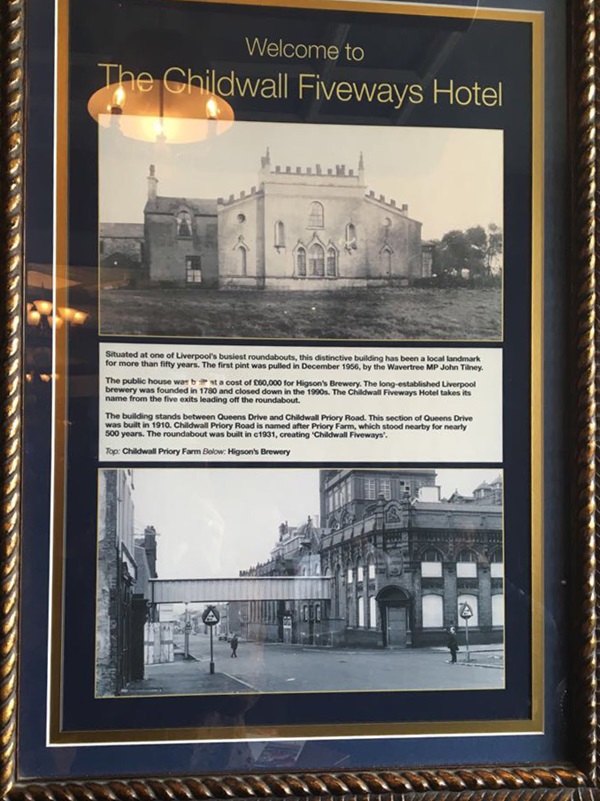
The text reads: Situated at one of Liverpool’s busiest roundabouts, this distinctive building has been a local landmark for more than fifty years. The first pint was pulled in December 1956, by the Wavertree MP John Tilney.
The public house was built at a cost of £60,000 for Higson’s Brewery. The long-established Liverpool brewery was founded in 1780 and closed down in the 1990s. The Childwall Fiveways Hotel takes its name from the five exits leading off the roundabout.
The building stands between Queens Drive and Childwall Priory Road. This section of Queens Drive was built in 1910. Childwall Priory Road is named after Priory Farm, which stood nearby for nearly 500 years. The roundabout was built in c1931, creating ‘Childwall Fiveways’.
Top: Childwall Priory Farm
Below: Higson’s Brewery
A plaque documenting the history of The Childwall Fiveways Hotel.
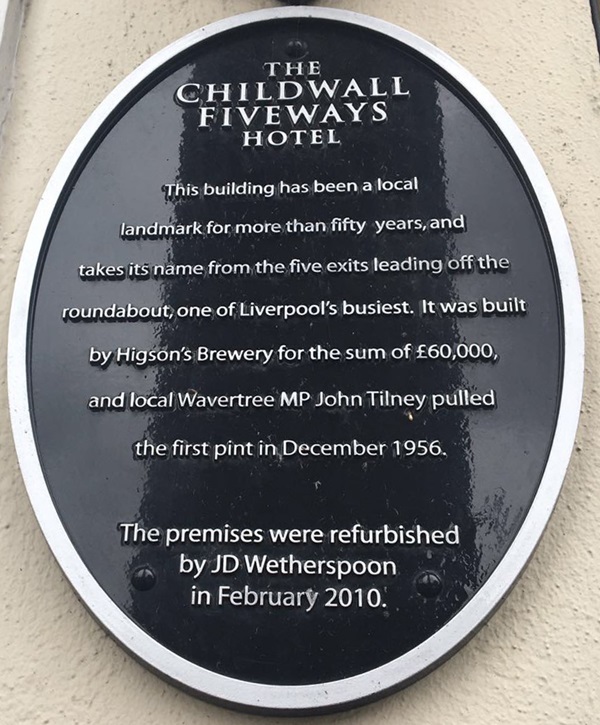
The text reads: This building has been a local landmark for more than fifty years, and takes its name from the five exits leading off the roundabout, one of Liverpool’s busiest. It was built by Higson’s Brewery for the sum of £60,000, and local Wavertree MP John Tilney pulled the first pint in December 1956.
The premises were refurbished by J D Wetherspoon in February 2010.
Photographs and text about heroes of Liverpool.

The text reads: Captain Frederick John Walker was called the U-boat Killer No.1. In the Battle of the Atlantic, Walker commanded a flotilla of six sloops with the instruction to hunt down U-boats wherever found. His flagship, The Starling, was involved in the sinking of fifteen U-boats including three in six hours. Tragically Walker suffered a stroke due to exhaustion and died on 9 July 1944, aged only 48.
During the Second World War, Derby House in Liverpool became the nerve centre for the Battle of the Atlantic. ‘Western Approaches’ is now a major tourist attraction.
Right: Captain Frederick John Walker
Top left: Some of Liverpool’s finest aboard HMS Fame
Left centre: Captured U-boat at Gladstone Dock
Above left: The Top Secret HQ at Derby House.
A photograph and text about Captain Noel Chavasse.
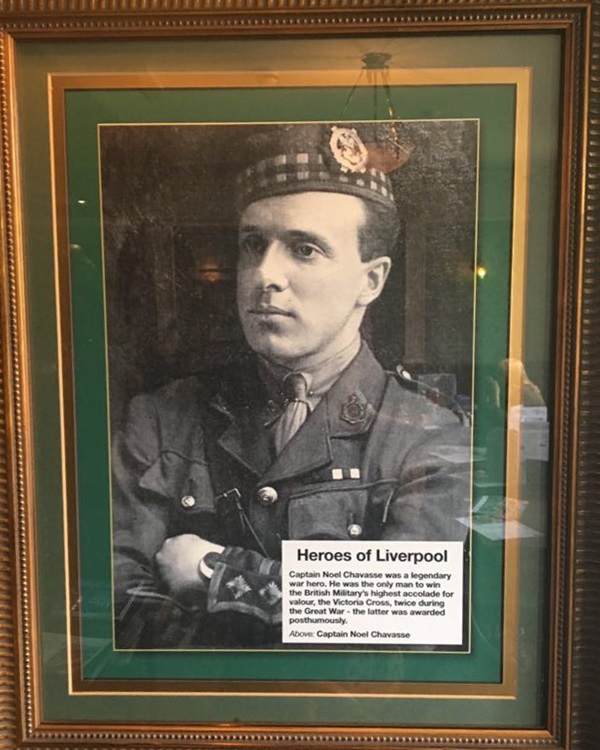
The text reads: Captain Noel Chavasse was a legendary war hero. He was the only man to win the British Military’s highest accolade for valour, the Victoria Cross, twice during the Great War – the latter was awarded posthumously.
Above: Captain Noel Chavasse.
Photographs and text about the Walker Art Gallery.
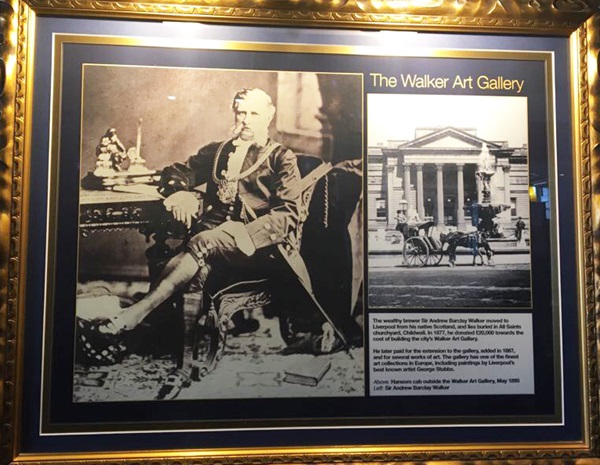
The text reads: The wealthy brewer Sir Andrew Barclay Walker moved to Liverpool from his native Scotland, and lies buried in All Saints churchyard, Childwall. In 1877, he donated £20,000 towards the cost of building the city’s Walker Art Gallery.
He later paid for the extension to the gallery, added in 1887, and for several works of art. The gallery has one of the finest art collections in Europe, including paintings by Liverpool’s best known artist George Stubbs.
Illustrations and text about the railway.
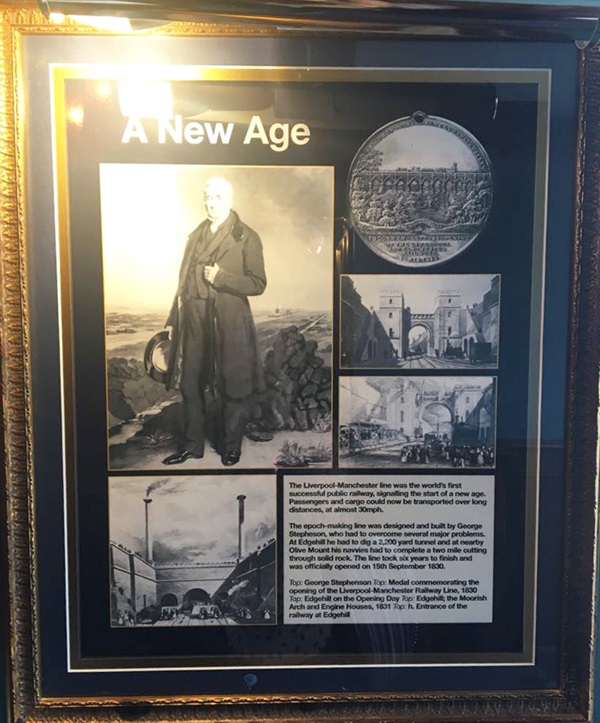
The text reads: The Liverpool-Manchester line was the world’s first successful public railway, signalling the start of a new age. Passengers and cargo could now be transported over long distances, at almost 30mph.
The epoch-making line was designed and built by George Stephenson, who had to overcome several major problems. At Edgehill he had to dig a 2,200 yard tunnel and at nearby Olive Mount his navvies had to complete a two mile cutting through solid rock. The line took six years to finish and was officially opened on 15 September 1830.
Top left: George Stephenson
Top right: Medal commemorating the opening of the Liverpool-Manchester Railway Line, 1830
Centre right: Edgehill on the Opening Day
Above: Edgehill; the Moorish Arch and Engine Houses, 1831
Left: Entrance of the railway at Edgehill.
Illustrations and text about Liverpool Overhead Railway.
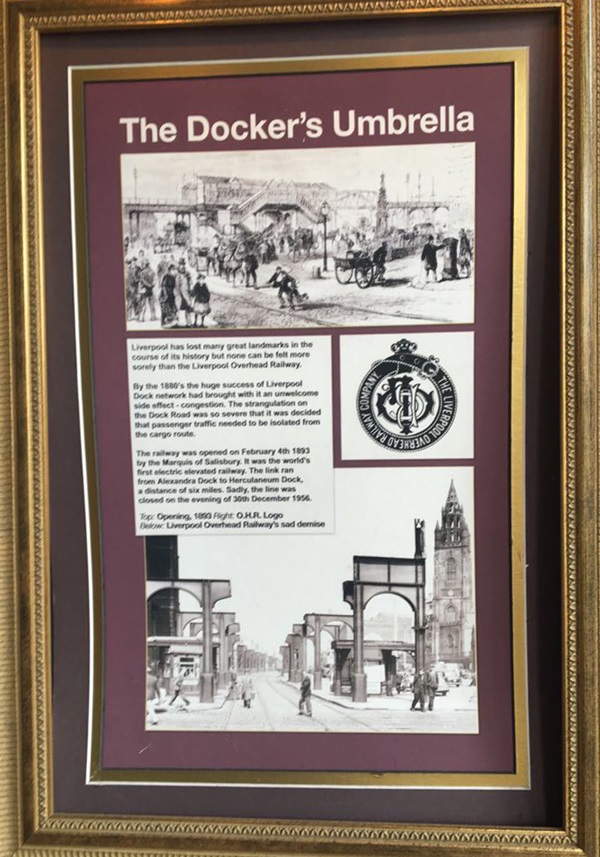
The text reads: Liverpool has lost many great landmarks in the course of its history but none can be felt more sorely than the Liverpool Overhead Railway.
By the 1880s the huge success of Liverpool Dock network had brought with it an unwelcome side effect – congestion. The strangulation on the Dock Road was so severe that it was decided that passenger traffic needed to be isolated from the cargo route. The railway was opened on February 4 1893 by the Marquis of Salisbury. It was the world’s first electric elevated railway. The link ran from Alexandra Dock to Herculaneum Dock, a distance of six miles. Sadly, the line was closed on the evening of 30 December 1956.
Top: Opening, 1893
Right: OHR Logo
Below: Liverpool Overhead Railways sad demise.
A photograph and text about Meccano.
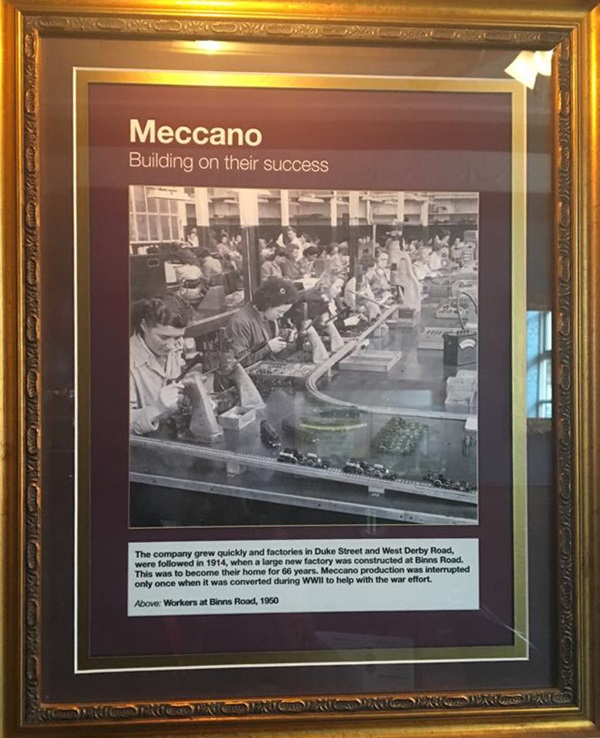
The text reads: The company grew quickly and factories in Duke Street and West Derby Road, were followed in 1914, when a large new factory was constructed at Binns Road. This was to become their home for 66 years. Meccano production was interrupted only once when it was converted during WWII to help with the war effort.
Above: Workers at Binns Road, 1950.
Prints and text about the history of Meccano.
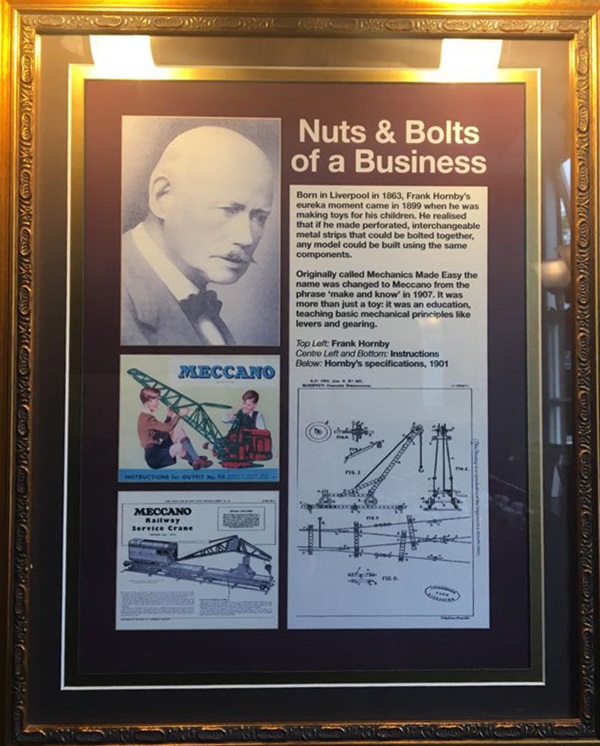
The text reads: Born in Liverpool in 1863, Frank Hornby’s eureka moment come in 1899 when he was making toys for his children. He realised that if he made perforated, interchangeable metal strips that could be bolted together, any model could be built using the same components.
Originally called Mechanisms Made Easy the name was changed to Meccano from the phrase “make and known” in 1907. It was more than just a toy: it was an education, learning basic mechanical principles like levers and gearing.
Top left: Frank Hornby
Centre left and bottom: Instructions
Below: Hornby’s specifications, 1901.
Prints of Meccano Magazine.
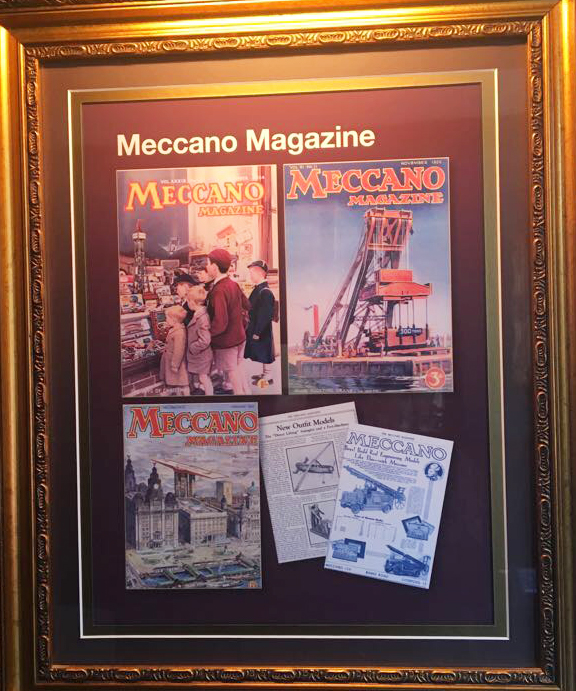
Photographs and text about The Beatles.

The text reads: No icon of pop music before or since can be said to have been so influential on a generation as the Beatles were on the ‘Swinging Sixties’.
By 1965, the worldwide success, the hordes of hysterical fans and the catchy pop songs perfectly captured on seven inch vinyl, guaranteed the fab four a place in the history of popular culture.
Top: 16 June 1966. Making their only live appearance on Top of the Pops
Left: In costume for a sketch in The Beatles Christmas Show.
Photographs and text about The Beatles.
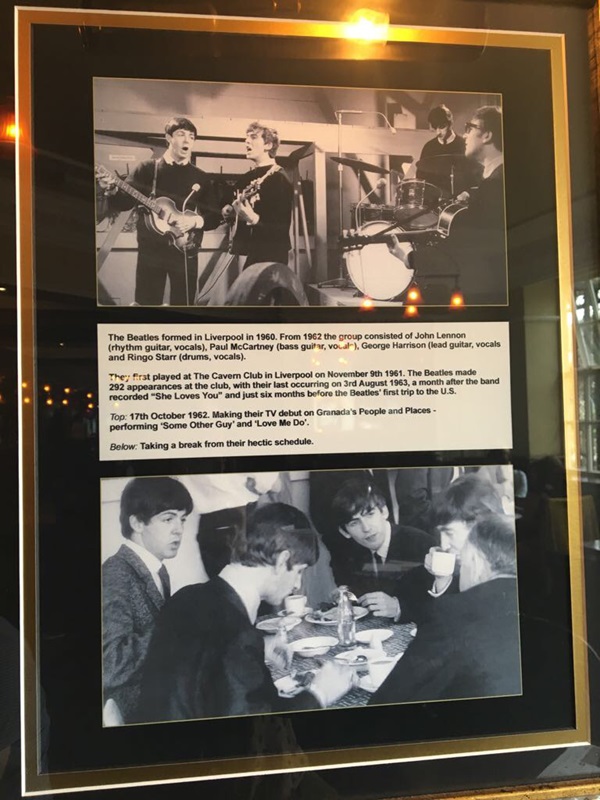
The text reads: The Beatles formed in Liverpool in 1960. From 1962 the group consisted of John Lennon (rhythm guitar and vocals), Paul McCartney (bass guitar, vocals), George Harrison (lead guitar, vocals) and Ringo Starr (drums, vocals).
They first played at The Cavern Club in Liverpool on November 9 1961. The Beatles made 292 appearances at the club, with their last occurring on 3 August 1963, a month after the band recorded She Loves You and just six months before the Beatles’ first trip to the US.
Top: 17 October 1962. Making their TV debut on Granada’s People and Places – performing Some Other Guy and Love Me Do.
Below: Taking a break from their hectic schedule.
A photograph and text about George Harrison.
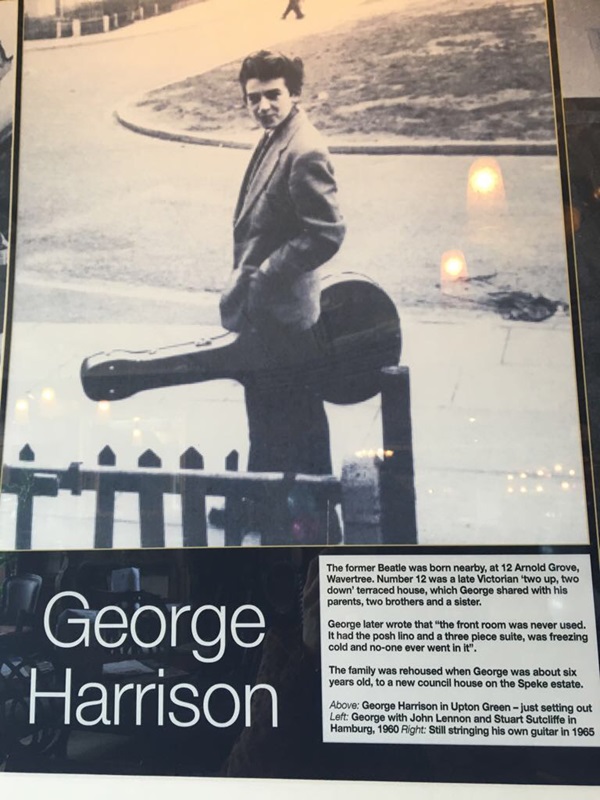
The text reads: The former Beatle was born nearby, at 12 Arnold Grove, Wavertree. Number 12 was a late Victorian two up, two down terraced house, which George shared with his parents, two brothers and a sister.
George later wrote that “the front room was never used. It had the posh lino and a three piece suite, was freezing cold and no-one ever went in it”.
The family was rehoused when George was about six years old, to a new council house on the Speke estate.
Above: George Harrison in Upton Green – just setting out
Left: George with John Lennon and Stuart Sutcliffe in Hamburg, 1960
Right: Still stringing his own guitar in 1965
Photographs and text about The Beatles.
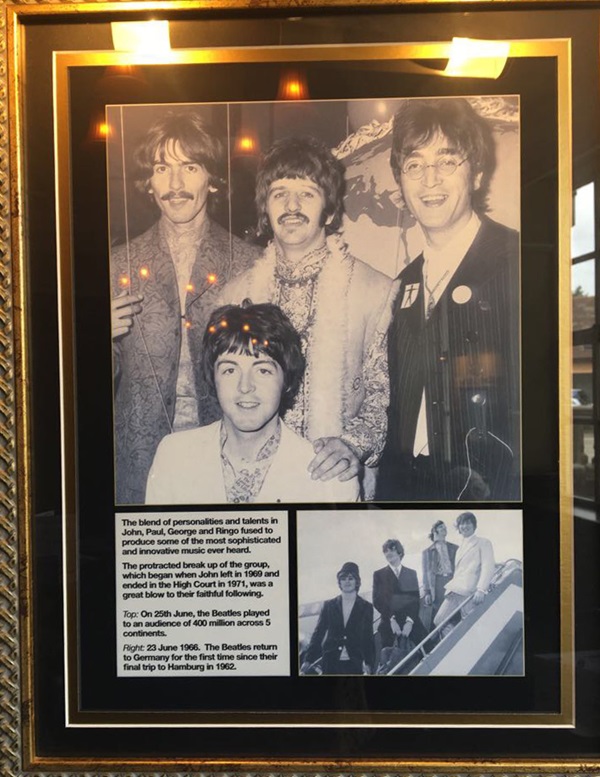
The text reads: The blend of personalities and talents in John, Paul, George and Ringo fused to produce some of the most sophisticated and innovative music ever heard.
The protracted breakup of the group, which began when John left in 1969 and ended in the High Court in 1971, was a great blow to their faithful following.
Top: On 25 June, The Beatles played to an audience of 400 million across 5 continents
Right: 23 June 1966. The Beatles return to Germany for the first time since their final trip to Hamburg in 1962.
This wall, outside the pub, is the exact wall that The Beatles are pictured jumping off, in the photograph.

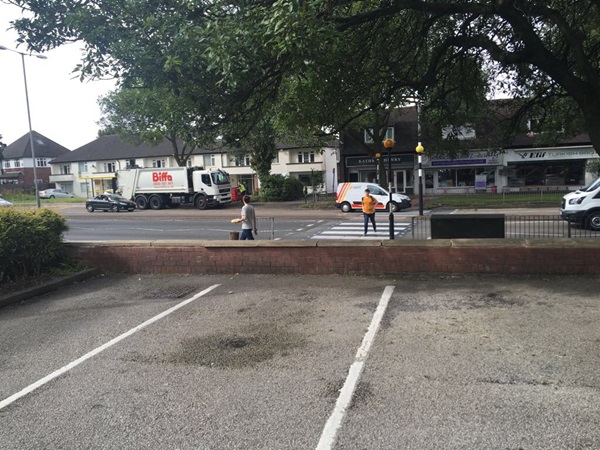
External photograph of the building – main entrance.
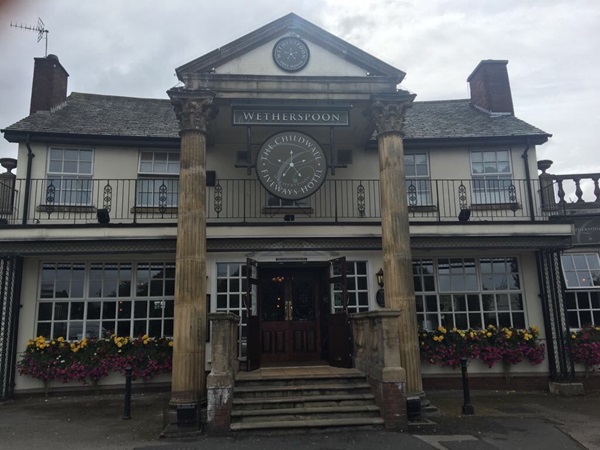
If you have information on the history of this pub, then we’d like you to share it with us. Please e-mail all information to: pubhistories@jdwetherspoon.co.uk